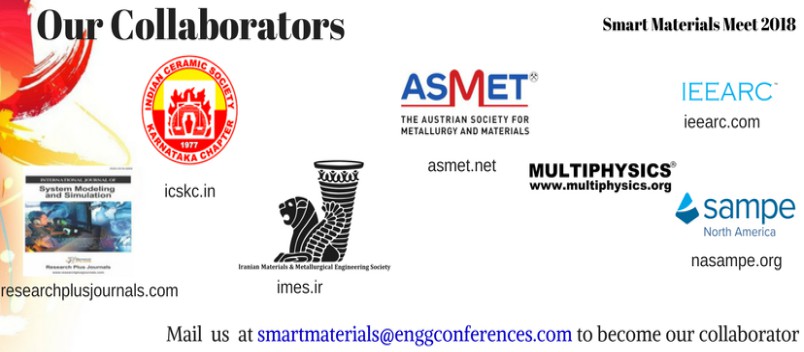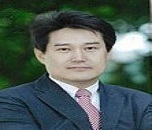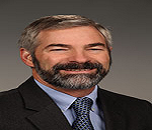Theme: Smart and Emerging Materials- Future Prospects
Smart Materials Meet 2018
- Welcome Message
- About Smart & Emerging Materials Conference
- Sessions/Tracks
- Market Analysis
- Latest Updates: Smart & Emerging Materials
ME Conferences organizes highly notable Material Science Conference throughout the globe. After a successful conference of Smart Materials and Structures 2017 , we are currently bringing forth “ 5th World Congress on Smart and Emerging Materials”(Smart Materials Congress 2018) slated on April 19-20, 2018 at Dubai, UAE. The conference invites all the participants across the globe to attend and share their insights and convey recent developments in the field of Smart and Emerging Materials.
2017 Highlights:
- 200+ Participation (50% Industry: 50% Academia)
- 9+ Keynote Speakers
- 30+ Plenary Speakers
- 3+ Exhibitors
- 14 Innovative Educational Sessions
- B2B Meetings
Exhibition:
Why exhibit?
- Make sales
- Debut new products
- Profile your brand
- Meet new business partners and suppliers
- Develop key relationships
- Educate material science, healthcare, automotive, textile, electrical, aerospace, defense and many more field related institutions
Who you will meet?
Leaders in:
- Material Science & engineering
- Civil/structural engineering
- Mechanical & Electrical engineering
- Nanotechnology
- Automotive & Aerospace fields
- Smart Materials
- Modern Smart Architecture
- Smart Clothing
- Defense Industries
- Mining & Metallurgy Field
- Biomedical Engineering
- Robotics
- Emerging Membrane Technologies
- Smart Food Packaging
- Manufacturing of Materials
- Applied Physics.
- Environmental Engineering.
- Healthcare & Diagnostics.
- Fuel Cell & Polymer Technology
- Energy storage and Efficiency
Who should sponsor?
- Material societies
- Material Science Associations
- Nanotechnology Associations
- Material science field related: Research Councils, Foundations, Institutions, Government Departments, Research Associations, Private and Nationalized Industries
Why you should attend?
- Get to the heart of why synthesis and processing of materials (Nano Materials or Bio Materials) is difficult. Dissect the challenges before looking for concrete solutions
- Discover how advances in the sector are impacting the society
- Explore the broadness in the field of Material Science.
- Understand how the field of Material Science is interlinked with other branches like medicine, energy, aerospace, and nanotechnology to develop and deliver solutions with strong scientific, clinical and commercial mind set.
- Discover the latest Smart and Emerging Materials.
- Be inspired by innovative case studies and realize the market demand and potential impact of products or solutions delivered from this field of science.
- Engage in the exciting event format with round tables, panels, showcases, speed networking and multiple conference tracks.
- Share experiences, insights and strategies in interactive peer-to-peer round tables.
- Hear more perspectives in one place –from large and small organizations of Materials, Biotech, Nanotech, Defense, Aerospace and academia.
- Discover how advancements in Material Science and Engineering are being implemented in practice for the benefit of the humankind.
Smart Materials Meet 2018
Smart Materials Meet 2018
It’s glad to organize “5h World Congress on Smart and Emerging Materials” (Smart Materials Meet 2018) in UAE on April 19-20, 2018 at Dubai after a similar series of conferences in consecutive years at USA over the last several years which met with great achievement in Business Conferencing.
On this auspicious occasion, Organizing Committee invites the participants from all over the globe to take part in this annual flagship conference with the theme “Smart and Emerging Materials-Future Prospects”. Smart and Emerging Materials Congress 2018 aims to proclaim knowledge and share new ideas among the professionals, industrialists and students from research areas of Materials Science, Environmental science , Biomedicine, Architecture, Nanotechnology, Chemistry and Physics to share their research experiences and indulge in interactive discussions and technical sessions at the event. The Conference will also have a space for companies and/or institutions to present their services, products, innovations and research results. If your company/organization is interested in participating in this event, contact us.
Smart Materials Meet 2018 is a 3-day event offering the Exhibition, at venue to showcase the new and emerging technologies and have wider sessions involving Keynote presentation, Oral, YRF ( student presentation), poster, e-poster presentations. World-renowned speakers and eminent delegates across the globe attending the conference, to share their valuable presentation on the most recent and advanced techniques, developments, and the newest updates are the prominent features of the conference.
Why to attend?
Smart and Emerging Materials Congress 2018 offers a fantastic opportunity to meet and make new contacts in the field of Materials Science and Engineering, by providing collaboration spaces and break-out rooms with tea and lunch for delegates between sessions with invaluable networking time for you. It allows delegates to have issues addressed on Smart and Emerging Materials, Materials Science by recognized global experts who are up to date with the latest developments in the Materials Science field and provide information on new techniques and technologies. This International Materials Science conference will feature world renowned keynote speakers, plenary speeches, young research forum, poster presentations, technical workshops and career guidance sessions.
Target Audience:
- Materials Science Engineers
- Nanotechnology Engineers
- Researchers from Mining and Metallurgy field
- Scientists and students from Tissue Science engineering and Biomaterials
- Delegates from Materials Science and Nanotechnology Associations
- Professors, Students, Researchers and Technical Staff from Materials Science and Nanotechnology Department
- Delegates from Materials Science, Semiconductor, Polymer, Fuel Cell and Energy related industries.
- Researchers and scientists from Environmental protection societies
- Architects, Civil and structural engineers
- Delegates from aerospace, defense and automobile industries
The joy of attending Smart and Emerging Materials Congress 2018 brings with it improvement and incremental growth in your approach to do things, in the broader manner to see things and the beauty to live international diversity.
Come be Part of it...!
Track 01: Material Science and Engineering
The new academic discipline emerged by fusion of metallurgy, ceramics, solid-state physics and chemistry is the field which deals with identification, study and design of materials. To understand ancient phenomenon in mineralogy and metallurgy researchers combined the knowledge of physics, chemistry, engineering which led to development of new field in science namely Material Science and Engineering or Material science. Several properties namely bonding nature, shape, form, magnetic, chemical, optical, electrical, thermal, physical and several other properties of a material is discovered so that the materials can be used to their maximum benefit in respective areas. The discipline is important both from a research perspective, as well as from an industrial one. When finding new materials, one encounters new discoveries which is yet to be discovered hence study and usage of the appropriate materials is crucial when designing systems.
Track 02: Smart Materials and Structures
Designing the combination of several different materials through modeling and simulation to have a material with desired property and structure is the concept behind Smart Materials and structures. They are hybrid materials composed of dissimilar phases which significantly change upon exposure to any applied external stimuli such as temperature, stress, magnetic or electric fields. Smart structures are devices composed of smart materials capable of sensing stimuli, responding to it and reverting to its original state after the stimuli is removed. They may be Ceramics, Alloys, Semiconductors or Polymers. Self-Healing Materials, Magnetocaloric and thermoelectric materials, Polycaprolactone are emerging smart structures. Smart structures have the ability to resist natural calamities.
Track 03: Emerging Materials
Stone, Bronze, Steel or Iron Ages led to growth of Ceramics, Minerals from where Metallurgy field developed. Discovery of Atoms/Molecules and Thermodynamics led to study of metals, alloys, silica and carbon nanomaterials. Material Science has now revolutionized to rubbers, plastics, semiconductors, biomaterials, polymers, magnetic materials, medicinal implant materials, nanomaterials etc and it doesn’t stop there yet! Several materials like LiTraCon, Silicene, Aerogels, Graphene, Fullerene, Metamaterials, Quantum Dots and Lithium Ion Batteries have been emerging. Their status being hypothetical, experimental or in use, these materials have found potential applications in health, aerospace, automobiles etc.
Track 04: Synthesis and Characterization
Manufacturing materials with desired structure and properties involves the use of several different processing step. As a researcher, the structure, property and processing of a material (Materials Paradigm) must be known. The material cannot be manufactured in industry and marketed if no economical and qualitative production method for it has been developed. Thus, the processing of materials is vital to the field of materials science. The materials paradigm helps in forensic engineering, failure analysis, and investigation of aviation accidents. Recently several smart materials have emerged through new production methods or modified synthesis steps.
Track 05: Property Changing Smart Materials
Smart materials are materials whose properties are engineered to change in a controlled manner under the influence of external stimuli. The materials which change their properties under any external influences like temperature, force, moisture, electric charge, magnetic fields and pH are called Property Changing Smart Materials. The characterization of a material’s atomic structure, micro structure, macro structure or nano structure is done through methods like diffraction with X-rays, Electrons or neutrons and various forms of spectroscopy and chemical analysis such as Raman spectroscopy, energy-dispersive spectroscopy (EDS), chromatography, thermal analysis and electron microscope analysis. The mechanical, chemical, thermal, electrical, optical and magnetic properties of the materials is studied and utilized through methods like crystallography, computational science, thermodynamics etc.
Track 06:Shape Changing Smart Materials
Shape-changing smart materials are materials and products which are able to reversibly change their shape in response to one or more stimuli like the effect of light, temperature, pressure, an electric or magnetic field, or a chemical stimulus. There are materials and products that are able to change their shape without changing their dimensions, and other materials and products that retain their shape but change their dimensions. Some are also able to change both parameters at the same time. Depending on the stimuli to which the materials respond, shape changing smart materials are classified as Piezoelectric materials, Photostrictive materials, Thermostrictive materials, Magnetostrictive materials and Chemostrictive materials.
Track 07: Nano Smart Materials
Nanotechnology is a rapidly developing field entering the world of smart materials and taking them to the next level. Nanotechnology enabled smart materials (Nanomaterials or Nano smart materials) may be able to change and recombine much like the shape shifting cyborg in the movie Terminator 2. They may incorporate Nano sensors, Nano computers and Nano machines into their structure (Nano Smart Structure or Smart Nano Structures) which may enable them to respond directly to their environment. As an example materials may be able to shape shift – comfortable, flexible clothing for motorcyclists could go rock hard if it detects an impact, or similar material worn by a police office could detect an approaching projectile and turn itself bullet proof. The field of nanomaterials is organized into organic (carbon-based) nanomaterials such as fullerenes and inorganic nanomaterials based on other elements, such as silicon. Examples of nanomaterials include fullerenes, carbon nanotubes, nanocrystals etc.
Track 08: Bioactive Smart Material:
The task of combining material science and biology can lead to production of smart bioactive materials or biomaterials which can find several applications. Several elements like medicine, biology, chemistry, material science and tissue engineering are employed in biomaterial science. The venture of developing these materials from nature or laboratory using metallic components, bioceramics, composite materials or ceramics and finding suitable ways of processing them and integrating them into existing systems is the current challenge to the research institutes and industry. Application of these materials may be benign like a heart valve or may be bioactive such as hip implants, autograft, allograft or organ transplant. They may be also used in surgery, dental applications, textile industries or drug delivery.
Track 09: Materials in Health and Biomedicine
Addressing a biological problem using materials is not a new concept, for example dental fillings, artificial hips, heart stents and orthopedic implants are non-biological materials being deployed in the human body to fulfill a health requirement. Advances in manufacturing processes combined with cross-talk between scientific and engineering disciplines have resulted in a rapidly emerging area within bioengineering to develop smart biomaterials. Next-generation biomaterials are rationally designed to serve the society through dental applications, artificial organs, surgery, drug delivery and veterinary devices, so materials have been applied in health and biomedicine as biomaterials.
Track 10: Materials in Environmental Bioremediation
Industrialization and modernization has led to several environmental issues like water pollution, water scarcity etc. Several materials and devices have been developed to serve as solutions to these problems for example the usage of absorbent pads to oil leakage problems and membrane filters for desalination. Smart materials being a novel concept promises hope to these problems. Hence Materials employed for environmental bioremediation is discussed in this track.
Track 11: Materials in Industry
Several processing methods like the casting, rolling, welding, ion implantation, crystal growth, thin film deposition, sintering, glassbowing and characterization methods like the electron microscopy, X-ray diffraction, calorimetry, nuclear microscopy(HEFIB),Rutherford backscattering, neutron diffraction, small angle X-ray scattering(SAXS) have been utilized to discover, characterize, extract materials and convert them to useful forms. Thus ingot casting, foundry methods, blast furnace extraction, and electrolytic extraction are all part of the required knowledge of a materials engineer in an industry. Over the years smart materials have got vast applications in several fields. Smart materials have recently been produced and employed by industries in synthesis of several other devices called smart structures.
Track 12: Materials for Energy Storage and Applications
Depletion of natural resources and worldwide increase in population has created a need for biofuels. For the growing need of production and energy storage, systems including diverse materials, operations and properties have been employed, for example batteries such as Lithium batteries are used in various types of mobile devices, including communication equipment, computers, entertainment devices, power tools, toys, games, lighting and medical devices. Semiconductor devices have replaced vacuum tubes and from these semiconductor materials diodes, transistors, light emitting diodes (LEDs) have emerged for energy efficiency. Silicon, Gallium, Germanium, silicon carbide and gallium nitride are some semiconductor materials. Smart materials employed in smart tools for wide range of applications and less wastage have huge possibilities in the coming future.
Track 13: Smarter Lifestyle
From the metallic alloys employed in domestic uses as utensils to the iron alloys employed in industries and construction, From a brittle glass to a scratch resistant corning gorilla glass, From diamond, carbon, silica to ceramics, silicon carbide, tungsten carbide, From furfural to composites, From resins to polymers (Plastics, Rubbers) and from new semiconductor materials to smart wearable technology, From moisturized fabrics to floating architecture and sea defense systems; it has become smarter lifestyle. Curiosity to redesign the earth's geography or a simple city has led to development of architecture, interior design, civil, structural and construction engineering. The existing materials proving difficult to be used by their behavior, hope for smart materials to be employed is awakened.
Track 14: Market Demand and Value
The support of Government with its initiatives, the initiative R&D investment in the industries and institutions and the adoption of smart material products among various end-user industries like defense & aerospace, automotive, and consumer electronics has driven the market of smart materials. There is a high demand for smart materials on account of potential growth in emerging economies as well as evolution in Internet of Things (IoTs).It is expected that the smart material market will attain up to billion dollars by 2022. The trend in the market and the factors impacting the market are studied in the track of Market demand and value of materials.
Track 15: Future of Materials
A good memory is not something which money can buy. Smart materials have the ability to return to their original shape after the removal of stress. Thus the memory of these will play a key role in the future, in a way that many types of products are designed and assembled in the future. The field of materials science and engineering being interdisciplinary with chemistry, condensed matter physics, mechanical engineering,chemical engineering, electrical engineering, tissue engineering, civil engineering and architecture holds future both from a scientific perspective, as well as from an engineering one. When discovering new materials, a lot of science of the material is to be discovered. Materials are of the utmost importance for engineers, as the usage of the appropriate materials is crucial when designing systems. As a result, materials science is an increasingly important part of an engineer's education. There are numerous applications for the technology in the automotive, aerospace, medical and electronics industries
Relevant Conferences:
Material Science Conference | Smart Material Events | Mechanical Engineering Conferences | Ceramics Congress | Materials Chemistry Meetings | Polymer Conferences | Aerospace Event | Smart Grid Technology | Biomaterials | Nano-materials | Materials Science
-
5th Chemistry Congress April 16-17, 2018 at Dubai, UAE
-
Advanced Materials Science Conferences August 27-29, 2018 at Dubai, UAE
-
Polymerization Conferences September 6-7, 2018 at Dubai, UAE
-
Nanotechnology Congress October 17-18, 2018 at Dubai, UAE
-
Materials Science and Nanotechnology Sep 25-26, 2017 Dubai, UAE
-
Energy and Materials Research December 6-7, 2017 Dallas, Texas, USA
-
Materials Research and Technology February 19-20, 2018 Paris, France
-
Smart Materials-2018 Conference March 6-8, 2018 Osaka, Japan
-
Materials Science and Engineering May 28-30, 2018 Osaka, Japan
-
Smart Material Research Conference November 15-17, 2017 Melbourne, Australia
-
Smart Materials Applications Conference (ICSMA 2018) January 26-20, 2018 at Singapore
-
Smart Engineering Materials Conference March 7-9, 2018 Romania
-
Smart Systems Conference April 11-12, 2018 at Germany
-
Emerging Materials Conference March 22-23, 2018 London, UK
-
Nanomaterials Conference March 15-16 2018 London, UK
-
Biomaterials Conference March 05-06 2018 Berlin, Germany
- Nanomedicine Conference April 18-19, 2018 Las Vegas, USA
- Smart Structures Conference April 16-17, 2018 Las Vegas, USA
Related Societies:
Alpha Sigma Mu, American Ceramic Society(ACerS), American Chemical Society (ACS), American Institute of Chemical Engineers (AIChE), American Society for Engineering Education(ASEE), American society for Non-Destructive Testing(ASNT), American society of Mechanical Engineers(ASME), American Welding Society(AWS), U.S. Council for Automotive Research, NACE International, The Corrosion Society, The American Society for Testing of Materials, American Institute of Physics, American Powder Metallurgy Institute, American Society of Body Engineers, American Society of Civil Engineers, American Vacuum Society, American Welding Society, Association For Manufacturing Technology, Association of Vacuum Equipment Manufacturers, Abrasive Engineering Society, American Founders men's Society, American Institute of Aeronautics and Astronautics, Federation of European Materials Societies (FEMS), European Association for Structural Dynamics , the Thermal Spray Society, International Magnesium Association, International Society of Coating Science and Technology, The International Thermal Spray Association, International Titanium Association, International Union of Materials Research Societies, Magnetic Materials Producers Association, National Society of Professional Engineers, SAE International, Semiconductor Research Corporation, Society of Engineering Science, UK Society for Biomaterials, Canadian Biomaterials Society, International Organization of Materials, Metals and Minerals Societies, International Union of Crystallography, International Union of Materials Research Societies, Materials Research Society, National Materials Advisory Board, Non-Ferrous Founders' Society, Royal Microscopy Society, Society for Biomaterials, Society for Mining, Metallurgy, and Exploration , Society for Biomaterials, Japan Society for Composite Materials, Society of Materials Science, Federation of Materials Societies, International Union of Crystallography, Bureau of International Recycling, Cast Metal Institute, Casting Industry Suppliers Association, Ductile Iron Society, Electrochem Society, Electronic Device Failure Analysis Society, Materials Research Society , Society for the Advancement of Material and Process Engineering, Society of Materials Science, International Union of Crystallography, The Minerals, Metals and Materials Society, The National Association of Corrosion Engineers, Engineer's Week, International Union of Crystallography, International Union for Biomaterials Science and Engineering(IUSBSE), Society for Biomaterials, Society for the advancement of Material and Process Engineering, Society of Material Science, Sigma Xi: The Scientific Research Society, International society for Optical Engineering (SPIE).Australasian Society for Biomaterials and Tissue Engineering , Australasian Ceramic Society, Brazilian Composite Materials Association
Theme: Smart and Emerging Materials-Future Prospects.
Summary:
Materials Science and Technology (MST) is a field of technology that deals with study of material types and how to use them after manufacturing. Materials may be metals, ceramics, polymers (plastics), semiconductors, and combinations of materials called composites. We live in a world that is both dependent upon and limited by materials. From the roads to the electronic goods used, everything we see and use is made of materials: cars, airplanes, computers, refrigerators, microwave ovens, athletic equipment of all types and even biomedical devices such as replacement joints and limbs. Smart Materials and Structures are hybrid materials and structures that are composed of dissimilar phases which significantly change if any external stimulus is applied such as temperature, stress, magnetic or electric fields. Smart Materials are combinations of at least two different materials, which allow the engineering of desired properties. Exciting new product developments frequently are possible only through new materials and/or processing. Emerging Materials technologies developed through engineering and science will continue to make startling changes in our lives in the 21st century. Smart materials are found commonly in industries such as aerospace, transportation, electronics, energy conversion, and biomedical systems. They have recently been employed in environmental bioremediation also. The future will bring ever-increasing challenges and opportunities for emerging materials and better processing. Materials are evolving faster today than at any time in history. New and improved materials are an "underpinning technology" - one which can stimulate innovation and product improvement. High quality products result from improved processing and more emphasis will be placed on reclaiming and recycling. For these many reasons, most surveys name the materials field as one of the careers with excellent future opportunities
We welcome you all to the 5th World Annual Congress on Smart and Emerging Materials. Smart and Emerging Materials 2018 gives you the life-time opportunity to explore and enrich your knowledge in material science and technology. This material science congress gives you the opportunity to interact with eminent and renowned academicians, scientists, industrialists and young scholars related to the field of Materials Science and Engineering under one roof in one dais to learn, share and prosper your knowledge in one of the most diverse and unexplored topic.
Importance& Scope:
Material science has always been with us from the ancient times and has always been the backbone of human’s evolution and development. Materials scientists lay stress on understanding how the history of a material influences its structure, and thus its properties and performance. All this factors have paved way for the improvement of the quality of human life to a great extent. Smart and Emerging Materials 2018 gives you the in-depth analysis of material science and new definition to your imaginations. Smart and Emerging Materials 2018 gives you the base to build your own castle of knowledge and make you completely ready, preparing you for the challenges in material science Industry.
Why Dubai, UAE?
Dubai is a city in the United Arab Emirates (UAE), located within the emirate. The emirate of Dubai is located on the southeast coast of the Persian Gulf and is one of the seven emirates that make up the country. Abu Dhabi and Dubai are the only two emirates to have veto power over critical matters of national importance in the country’s legislature. The city of Dubai is located on the emirate’s northern coastline and heads up the Dubai-Sharjah-Ajman metropolitan area.
Dubai has a fascinating history and a vibrant heritage that provides visitors an intriguing glimpse into Arabian culture. A place to start exploring the heritage and history of Dubai is the Dubai Museum: it’s located inside the Al Fahidi Fort, one of the Dubai’s oldest buildings dating back to 1787.
Glitzy Dubai is the United Arab Emirates holiday hot spot. This city of high-rises and shopping malls has transformed itself from a desert outpost to a destination du-jour, where tourists flock for sales bargains, sunshine and family fun. Dubai is famous for sightseeing attractions such as the Burj Khalifa (the world’s tallest building) and shopping malls that come complete with mammoth aquariums and indoor ski slopes. But this city has many cultural highlights and things to do as well as all the glamorous modern add-ons. Take a wander around the Bastakia district, and you’ll discover the Dubai of old, then cruise along Dubai Creek in a traditional dhow and you’ll soon realize there’s more to this city than its flashy veneer.
Why to attend?
Smart and Emerging Materials 2018 paves a platform to globalize the research by installing a dialogue between industries and academic organizations and knowledge transfer from research to industry. Smart and Emerging Materials 2018 aims in proclaim knowledge and share new ideas amongst the professionals, industrialists and students from research areas of Materials Science and Nanotechnology to share their research experiences and indulge in interactive discussions and special sessions at the event.
New Hope for Dentistry and Medicine: Smart Materials can now regenerate tissue and fight cavity
Materials have been employed for several medicinal applications however the cons and shelf life of the material employed was a thinking matter. The discovery of materials which can self-heal gave hope to regenerative medicine and tissue engineering researchers. The several forms and synthesis of these smart materials has now given hope to even dentists and patients to fight against tooth decay. Further studies and developments in this field can help a lot in the future.
Source: Science Daily
Recent Innovations in Energy and Wearable Technology

Scientists have discovered a crystalline material called the Perovskite crystals which change shape in response to light thus efficiently converting sunlight into electricity and developing novel light-activated devices which might have much greater potential than the solar panels. The employment of Smart Materials has been observed in wearable technology fields too as piezoelectric materials, sensors etc.
Source: Pune Mirror India Times
Conference Highlights
- Material Science and Engineering
- Smart Materials and Structures
- Emerging Materials
- Synthesis and Characterization
- Property Changing Smart Materials
- Shape Changing Smart Materials
- Nano Smart Materials
- Bioactive Smart Materials
- Materials in Health and Biomedicine
- Materials in Environmental Bioremediation
- Materials in Industry
- Materials for Energy Storage and Applications
- Smarter Lifestyle
- Market Demand and Value
- Future of Materials
- Entrepreneurs Investment Meet
To share your views and research, please click here to register for the Conference.
To Collaborate Scientific Professionals around the World
| Conference Date | April 19-20, 2018 | ||
| Sponsors & Exhibitors |
|
||
| Speaker Opportunity Closed | Day 1 | Day 2 | |
| Poster Opportunity Closed | Click Here to View | ||
Useful Links
Special Issues
All accepted abstracts will be published in respective Our International Journals.
- Journal of Material Sciences & Engineering
- Journal of Powder Metallurgy & Mining
- Journal of Nanosciences: Current Research
Abstracts will be provided with Digital Object Identifier by


















































































